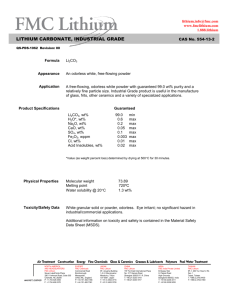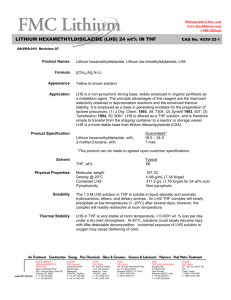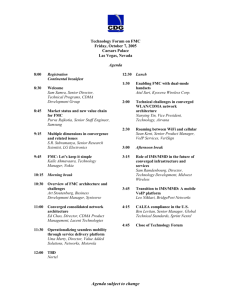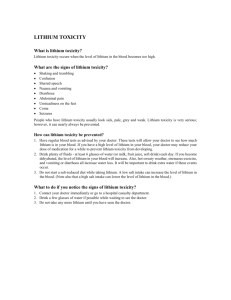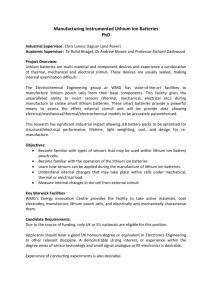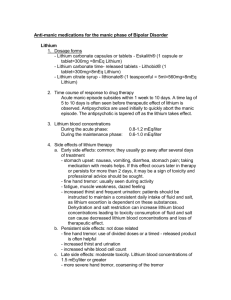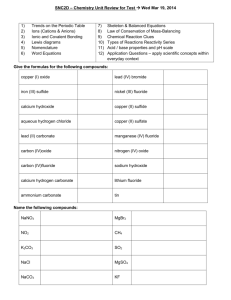Lithium Carbonate
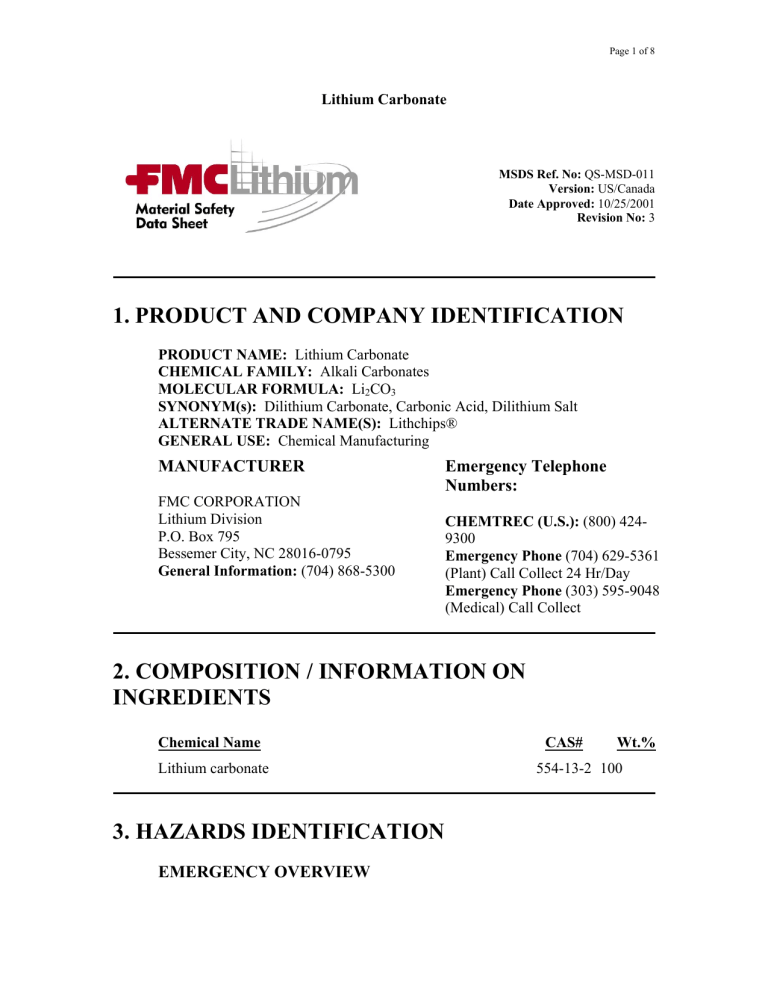
Page 1 of 8
Lithium Carbonate
MSDS Ref. No: QS-MSD-011
Version: US/Canada
Date Approved: 10/25/2001
Revision No: 3
1. PRODUCT AND COMPANY IDENTIFICATION
PRODUCT NAME: Lithium Carbonate
CHEMICAL FAMILY: Alkali Carbonates
MOLECULAR FORMULA: Li
2
CO
3
SYNONYM(s): Dilithium Carbonate, Carbonic Acid, Dilithium Salt
ALTERNATE TRADE NAME(S): Lithchips®
GENERAL USE: Chemical Manufacturing
MANUFACTURER Emergency Telephone
Numbers:
FMC CORPORATION
Lithium Division
P.O. Box 795
Bessemer City, NC 28016-0795
General Information: (704) 868-5300
CHEMTREC (U.S.): (800) 424-
9300
Emergency Phone (704) 629-5361
(Plant) Call Collect 24 Hr/Day
Emergency Phone (303) 595-9048
(Medical) Call Collect
2. COMPOSITION / INFORMATION ON
INGREDIENTS
Chemical Name
Lithium carbonate
CAS# Wt.%
554-13-2 100
3. HAZARDS IDENTIFICATION
EMERGENCY OVERVIEW
Page 2 of 8
IMMEDIATE CONCERNS: White granular solid or powder, odorless.
POTENTIAL HEALTH EFFECTS: Eye irritant; no significant hazard in industrial/commercial applications.
COMMENTS:
(See Section 11, Toxicological Information)
4. FIRST AID MEASURES
EYES: Flush with water for at least 15 minutes. If irritation occurs and persists, contact a medical doctor.
SKIN: Wash with plenty of soap and water. Get medical attention if irritation occurs and persists.
INGESTION: Drink 1 or 2 glasses of water. Never give anything by mouth to an unconscious person. If any discomfort persists, obtain medical attention.
INHALATION: Remove to fresh air. If breathing difficulty or discomfort occurs and persists, obtain medical attention.
NOTES TO MEDICAL DOCTOR: Lithium carbonate has low toxicity and may produce moderate irritation. Treatment is symptomatic and supportive.
5. FIRE FIGHTING MEASURES
FLAMMABLE LIMITS: Not applicable
GENERAL HAZARD: No known physical hazard, non-combustible.
EXTINGUISHING MEDIA: Dry chemical, CO2, water spray or regular foam.
HAZARDOUS COMBUSTION PRODUCTS: None
FIRE FIGHTING PROCEDURES: Wear full protective clothing and self-contained breathing apparatus (SCBA) approved for fire fighting.
This is necessary to protect against the hazards of heat, products of combustion and oxygen deficiency. Do not breathe smoke, gases or vapors generated.
AUTOIGNITION TEMPERATURE: Not applicable
PROPERTIES CONTRIBUTING TO FLAMMABILITY:
None
FLASH POINT: Not applicable
SENSITIVITY TO STATIC DISCHARGE: Not applicable
SENSITIVITY TO IMPACT: Not applicable
COMMENTS:
(See Section 10, Stability and Reactivity)
Page 3 of 8
6. ACCIDENTAL RELEASE MEASURES
RELEASE NOTES: Sweep up and place in suitable container.
Dispose of waste according to local and Federal laws and regulations.
Before cleanup measures begin, review the entire MSDS with particular attention to Section 3, Emergency Overview and Potential Health Effects; and Section 8, Recommended Personal Protective Equipment.
7. HANDLING AND STORAGE
HANDLING: Avoid contact with eyes, skin or clothing. Use with adequate ventilation. Wear safety glasses or goggles and rubber gloves.
Wash thoroughly after handling.
STORAGE: Keep away from strong acids. Keep container closed.
8. EXPOSURE CONTROLS / PERSONAL
PROTECTION
ENGINEERING CONTROLS: Use local exhaust ventilation to keep airborne concentrations below exposure limits.
PERSONAL PROTECTIVE EQUIPMENT
EYES AND FACE: Safety glasses or goggles
RESPIRATORY: When engineering controls are not adequate, wear a
NIOSH/MSHA respirator approved for protection against inorganic dusts.
PROTECTIVE CLOTHING: Rubber gloves
WORK HYGIENIC PRACTICES: Quick-drench eyewash and safety shower.
COMMENTS:
EXPOSURE LIMITS:
None established
9. PHYSICAL AND CHEMICAL PROPERTIES
Page 4 of 8
ODOR: Odorless
APPEARANCE: Solid, white granular or powder pH: (1% Slurry) @ 25ºC: 11.2
PERCENT VOLATILE: Not applicable
VAPOR PRESSURE: Not applicable
VAPOR DENSITY: Not applicable
BOILING POINT: Decomposes at 1310°C (2390°F)
MELTING POINT: 720ºC (1330ºF)
SOLUBILITY IN WATER: 1.3 g/100 cc @ 20ºC
EVAPORATION RATE: Not applicable
SPECIFIC GRAVITY: 2.1 g/cc
MOLECULAR WEIGHT: 73.89
COEFF. OIL/WATER: Not applicable
ODOR THRESHOLD: Not applicable
10. STABILITY AND REACTIVITY
CONDITIONS TO AVOID: Contact with acids
STABILITY: Stable
POLYMERIZATION: Will not occur
HAZARDOUS DECOMPOSITION PRODUCTS: None
INCOMPATIBLE MATERIALS: Acids
11. TOXICOLOGICAL INFORMATION
EYE EFFECTS: Moderately irritating (rabbit) [FMC I87-0998]
SKIN EFFECTS: Minimally irritating; PII = 0.3/8.0 (rabbit) [FMC
I87-0999]
DERMAL LD
50
ORAL LD
50
: >2000 mg/kg (rat), [FMC I93-1799]
: = 525 mg/kg (rat), [RTECS 1983]
INHALATION LC
50
: >0.80 mg/L (4 hr. rat); No mortality at maximum attainable concentration, [FMC I93-1800]
SENSITIZATION: Non-sensitizer (guinea pig) [FMC I93-1801]
ACUTE EFFECTS FROM OVEREXPOSURE: Lithium carbonate has low oral and dermal toxicity and is moderately irritating to the eyes. It is not sensitizing and is essentially non-irritating to the skin.
CHRONIC EFFECTS FROM OVEREXPOSURE: The use of this product in industrial and commercial applications presents no significant toxicity hazard. The symptoms described below are based on
Page 5 of 8 therapeutic applications where relatively large doses are taken orally by medically supervised patients.
Lithium carbonate is used therapeutically at 500-2000 mg/day oral doses for specific mental disorders. Therapeutic effects occur at blood levels of
2.8 - 8.3 mg of lithium per liter. Minimal signs of toxicity may also occur at these therapeutic levels and involve primarily gastrointestinal upset.
Increased dosage can produce tremors, drowsiness and unsteady gait.
Signs of toxicity resolve rapidly on cessation of treatment. Prolonged treatment at toxic levels result in dehydration, kidney damage, weight loss and thyroid disturbances.
Some studies of pregnant mice and rats were associated with birth defects but only at dose levels large enough to produce signs of severe maternal toxicity. Although data from the 1970's and 1980's suggested an increase in cardiovascular defects in babies born in women on lithium carbonate therapy, more recent studies have not found any association between lithium exposure and birth defects. Women receiving therapeutic lithium carbonate treatment at the time of confinement have the potential for delivery of a fetus with poor muscle tone, slowed heart rate and cyanosis.
Full recovery usually occurs within 2-10 days postpartum. Therapeutic and greater levels of lithium may pose a risk to the conceptus and potential benefits to the mother are weighed carefully in clinical situations.
Exposure to lithium in industrial settings is not considered to pose a risk to human health. NIOSH studied 25 workers exposed to lithium-containing dust at air concentrations exceeding 10 mg/m³ (nuisance dust limit) and found that typical industrial exposure to lithium will not result in blood levels sufficiently high to produce toxicity in either adults or their offspring. [Health Hazard Evaluation report HHE80-036-922]
CARCINOGENICITY:
IARC: Not listed
NTP: Not listed
OSHA: Not listed
OTHER: ACGIH: Not listed
12. ECOLOGICAL INFORMATION
ECOTOXICOLOGICAL INFORMATION:
Lithium carbonate is expected to be moderately toxic to aquatic invertebrates and freshwater fish.
Page 6 of 8
Daphnia magna: 48 hr. EC50 = 33.2 mg/L [FMC Study I96-2085]
Rainbow trout: 96 hr. LC50 = 30.3 mg/L [FMC Study I96-2086]
CHEMICAL FATE INFORMATION: No data available for the product.
13. DISPOSAL CONSIDERATIONS
DISPOSAL METHOD: Dispose of waste according to local and
Federal laws and regulations.
14. TRANSPORT INFORMATION
COMMENTS: U. S. DOT, INTERNATIONAL MARITIME, AND
INTERNATIONAL AIR
Proper Shipping Name: None
Classification: None
Labels: None
UN Number: None
Packing Group: None
15. REGULATORY INFORMATION
UNITED STATES
SARA TITLE III (SUPERFUND AMENDMENTS AND
REAUTHORIZATION ACT)
SARA TITLE III SECTION 302 EXTREMELY
HAZARDOUS SUBSTANCES (40 CFR 355): Not listed
SECTION 311 HAZARD CATEGORY (40 CFR 370):
Immediate (Acute) Health Hazard
SECTION 313 REPORTABLE INGREDIENTS (40 CFR
372): This product contains lithium carbonate which is subject to the reporting requirements of Section 313 of the Emergency Planning and
Right-To-Know Act of 1986.
This information must be included in all MSDS's that are copied and distributed for this material.
Page 7 of 8
CERCLA (COMPREHENSIVE ENVIRONMENTAL RESPONSE
COMPENSATION AND LIABILITY ACT)
CERCLA REGULATORY (40 CFR 302.4): Not listed
TSCA (TOXIC SUBSTANCE CONTROL ACT)
TSCA INVENTORY (40 CFR 710, SUBPART B): This product is not subject to TSCA 12 (b) Export Notification Requirements.
TSCA STATUS (40 CFR 710): Listed
STATE REGULATIONS
California Proposition 65: WARNING. This product contains a chemical known to the State of California to cause reproductive toxicity.
CANADA
WHMIS (WORKPLACE HAZARDOUS MATERIALS
INFORMATION SYSTEM): Product Identification No.: None
Hazard Classification: Class D, Division 2B (Eye irritant)
Ingredient Disclosure List: Not listed
16. OTHER INFORMATION
REVISION SUMMARY Revision #: 3
This MSDS replaces Revision #2, dated June 21, 1999. Any changes in information are as follows: Section(s): 8 & 16
NFPA RATING
HEALTH:
FLAMMABILITY
REACTIVITY:
1
0
0
SPECIAL: None
This MSDS has been prepared to meet U. S. OSHA Hazard communication Standard, 29
CFR 1910.1200 and Canada's Workplace Hazardous Materials Information System
(WHMIS) requirements. type 1b
©2002 FMC Corporation. All Rights Reserved.
FMC Lithium, the FMC Lithium logo and Lithchips are trademarks of FMC Corporation.
Page 8 of 8
